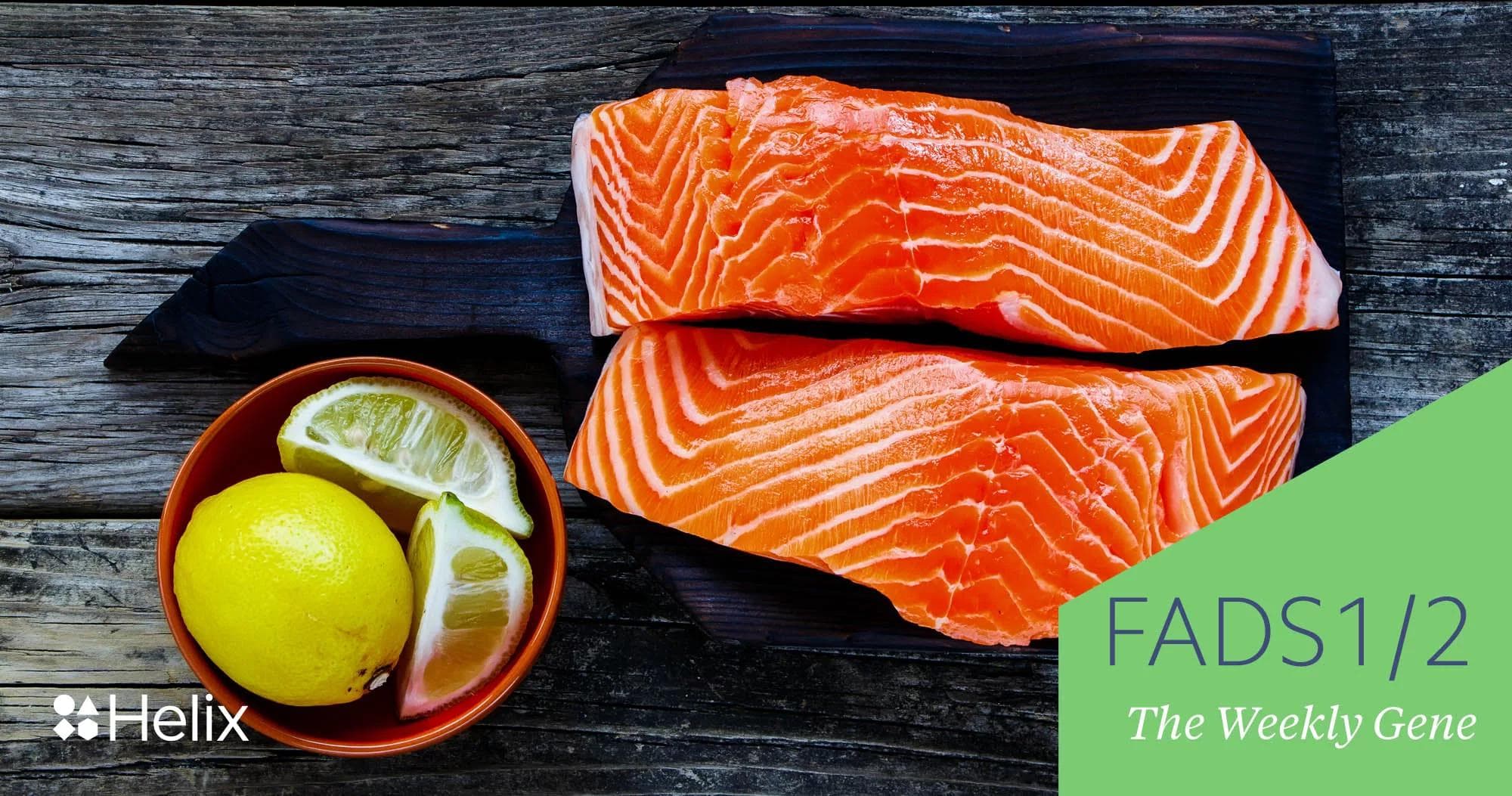How does your body process fat? Find clues in your DNA

Not all fats are created equally. Some dietary fats are considered more healthy for you than others. This is because the so-called “good” fat is heavily involved in brain and immune function, while other types of fat are considered “bad” due to their associations with cardiovascular disease. Generally, the process of synthesizing and consuming fat is an evolutionary advantage; however, changes in the DNA may alter the body’s ability to regulate the amount of “good” or “bad” fat in the system. In particular, genes called FADS1 and FADS2 have been repeatedly linked to fat synthesis which may influence how our body processes different types of fat.
The term “fat” can mean many things. In a large, structural sense, it refers to various types of body tissue that store molecular fat; in a molecular sense, it refers to a diverse class of molecules characterized by long hydrocarbon chains that are capped by triglycerides. Although they can all be grouped under the general category of “fat,” different types of fat molecules can have dramatically different effects on the body. For instance, a subtype of fat known as polyunsaturated fatty acids—or PUFA for short—are associated with a decreased likelihood of cardiovascular disease1. In contrast, another subtype (saturated fatty acids) are associated with an increased likelihood of cardiovascular disease2. These differences reflect the diverse range of functions for the different fats in our body. Some are used to help build cell membranes, the structures that define the outer limit of a cell. Other types of fat help synthesize hormones, transport molecules through the blood, or stimulate the immune system.
The many diverse functions of fat make it an important nutritional component, which may have driven our bodies to evolve the ability to synthesize some of the more important types of fat molecules. Long chain polyunsaturated fatty acids (LC-PUFA) help our immune system fight off pathogens1,3,4. Ancient human ancestors acquired LC-PUFAs through a diet rich in red meat; however, when humans switched from hunting and gathering over to agricultural societies, the ratio of red meat in our diet dramatically declined. Evidence suggests that humans began to accumulate changes in their FADS genes which allowed them to synthesize LC-PUFA from shorter fatty acids found in plants, like wheat and other grains3. Developing this ability may have provided an evolutionary advantage to our ancestors and allowed them to compensate for the decrease in red meat consumption.

Whether it’s good fat or bad fat, moderation is important.
Like our ancestors, modern day humans also have variation in their FADS genes4,5. These genes—FADS1 and FADS2—produce proteins that are critically involved in generating LC-PUFA from shorter fatty acids. Large scale genetic studies have found that specific variations in the DNA near these genes are associated with changes in the body’s ability to synthesize certain LC-PUFAs4,5. Research is currently looking into how these changes may affect the body’s ability to process and retain dietary fats, and some evidence indicates that individuals with decreased FADS1 or FADS2 function may benefit from increased consumption of LC-PUFA (such as those found in fish oil) in their diet4. Although it’s not entirely clear how these changes interact with a person’s diet, there is reason to believe that learning about how the body processes fat can encourage an increase in the amount of “good fat” a person consumes6.
Whether it’s good fat or bad fat, moderation is important. There is no disagreement that high fat diets can have negative health implications1,2. But it is important to recognize that the term “fat” covers a broad range of molecules, some of which can be beneficial for the body. Learning about your body’s ability to process fat and how DNA might be impacting this could help you make healthy choices when planning your next meal.
To learn more about your DNA and body fat processing, check out some of the products in the Helix Store that explore the DNA around FADS genes like embodyDNA by Lose It! and Azumio’s Calorie Mama. And if you’re interested in learning about how the switch from hunter-gatherer culture to agriculture may have affected your genetics, check out Metabolism by Insitome, which can help you explore this very question.
- Ander, Bradley P et al. “Polyunsaturated Fatty Acids and Their Effects on Cardiovascular Disease.” Experimental & Clinical Cardiology 8.4 (2003): 164–172. PMC. Web. 13 Dec. 2017
- Briggs, Michelle A., Kristina S. Petersen, and Penny M. Kris-Etherton. “Saturated Fatty Acids and Cardiovascular Disease: Replacements for Saturated Fat to Reduce Cardiovascular Risk.” Ed. Sampath Parthasarathy. Healthcare 5.2 (2017): 29. PMC. Web. 13 Dec. 2017.
- Marciniak, Stephanie, and George H. Perry. “Harnessing ancient genomes to study the history of human adaptation.” Nature Reviews Genetics, vol. 18, no. 11, Nov. 2017, pp. 659–674., doi:10.1038/nrg.2017.65. Web. 13 Dec. 2017.
- Al-Hilal, Maryam et al. “Genetic Variation at the FADS1-FADS2 Gene Locus Influences Delta-5 Desaturase Activity and LC-PUFA Proportions after Fish Oil Supplement.” Journal of Lipid Research 54.2 (2013): 542–551. PMC. Web. 13 Dec. 2017.
- Tanaka, Toshiko et al. “Genome-Wide Association Study of Plasma Polyunsaturated Fatty Acids in the InCHIANTI Study.” Ed. Michel Georges. PLoS Genetics 5.1 (2009): e1000338. PMC. Web. 13 Dec. 2017.
- Roke, Kaitlin et al. “Evaluating Changes in Omega-3 Fatty Acid Intake after Receiving Personal FADS1 Genetic Information: A Randomized Nutrigenetic Intervention.” Nutrients 9.3 (2017): 240. PMC. Web. 13 Dec. 2017.